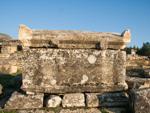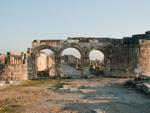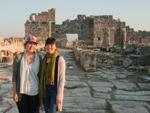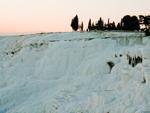From Ephesus we rushed to Pamukkale, hoping to reach before sunset. The Pamukkale translates to cotton castle due to it snow white travertines formed by the flowing hot springs. Situated overlooking Pamukkale is the ancient city of Hierapolis, translating to Holy City, one of the cities feature is an extensive Necropolis following the main road.
thydzikgooglemap(http://sonyaandtravis.com/maps/turkey-2011-ephesus-to-pamukkale.xml)
We arrived at the north entrance to Hierapolis late in the afternoon, a little confused as we couldn’t see any sign of the white travertines. As we entered the old city, we released we had come through the back and had to make a two kilometre journey through the necropolis. It was an amazing experience though and nothing I had seen before, hundreds of giant tombs and stone coffins on either side.
Approaching the city we reached the Northern Roman Baths with stone arches still intact. The entrance to Hierapolis is marked by Domitianus Gate consisting of three large arches with the remains of two watchtowers on either side. The main ancient city consisted of a Nymphaeum, the Temple of Apollo, a Plutonium and an Agora.
Moving to the southern outskirts of Hierapolis we reached Pamukkale, initially travertines were very small, but as we moved closer we were presented with a cliff of white. We removed our shoes (to protect the formations) and walked down. An amazing experience. We took as many photos as we could before the sun set and then made our way back through the Necropolis.
thydzikgooglemap(http://sonyaandtravis.com/maps/turkey-2011-hierapolis-pamukkale.xml,s)
That night we made a long drive to Kütahya, where we stayed at a old, dingy hotel for the night on the way to Istanbul.
thydzikgooglemap(http://sonyaandtravis.com/maps/turkey-2011-pamukkale-to-kutahya.xml)

































































































































